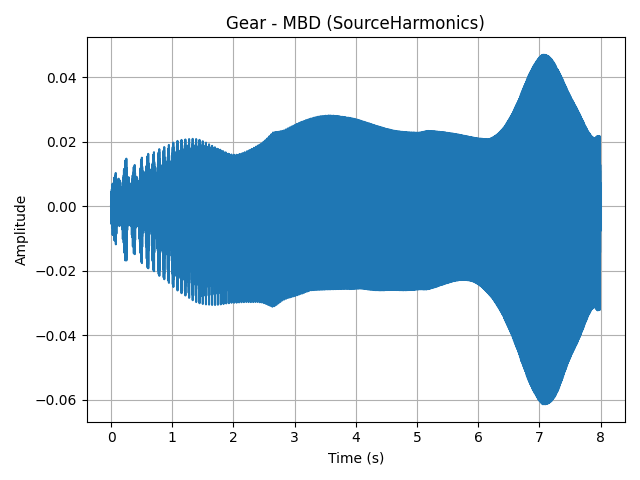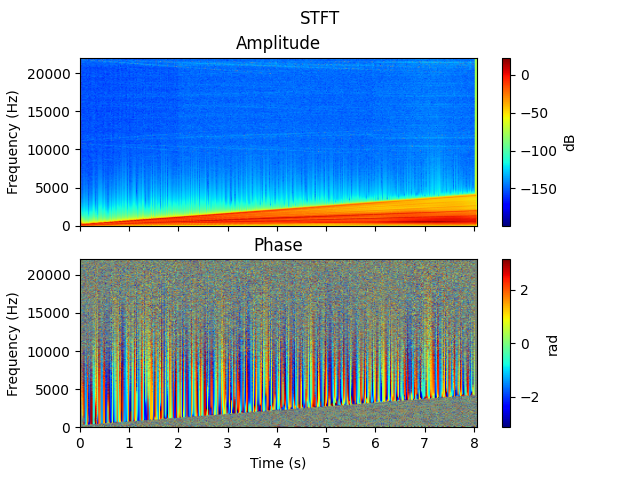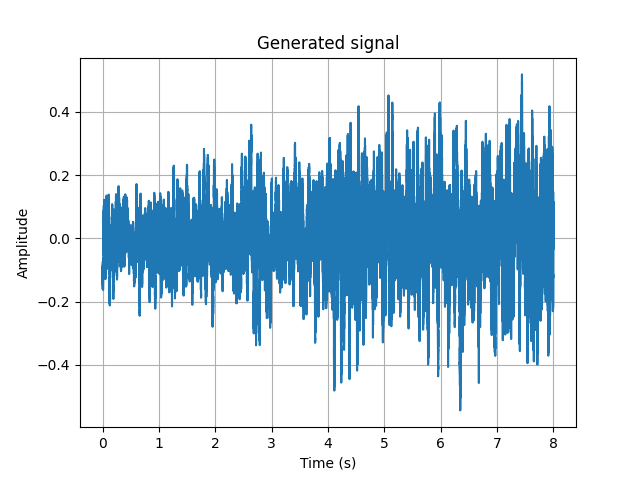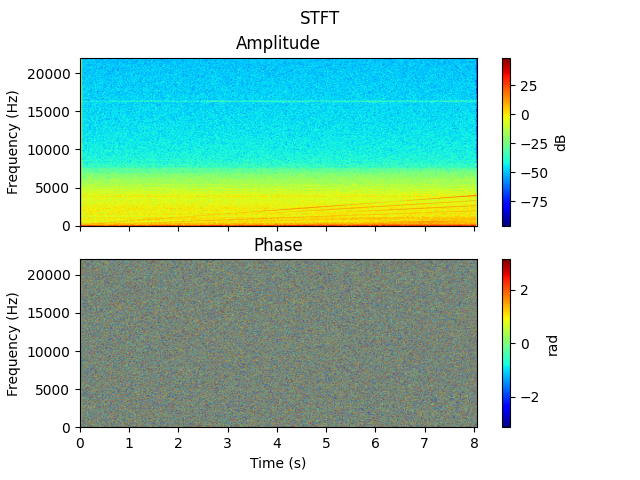Note
Go to the end to download the full example code.
Use an existing Sound Composer project file#
The Sound Composer is a tool that allows you to generate the sound of a system by combining the sounds of its components, which we call sources here. Each source can be made of data coming from test analysis, or from a simulation, or simply consist of a single audio recording. The sources are combined into a Sound Composer project, where each source is assigned to a track.
A track is a data structure made of a source data, a source control data, an output gain, and, optionally, a transfer function in the form of a digital filter (which models the transfer from the source to the listening/recording position). It can generate the sound of the component (as characterized by the source data), in specific operating conditions (the source control), and filtered according to the transfer function.
This example shows how to use the Sound Composer, with the SoundComposer class. It starts
from an existing Sound Composer project file, and illustrates the notions of Sound Composer project,
track, source, source control, and filter.
The example shows how to perform these operations:
Load a project file,
Get the project information and content,
Investigate the content of a track,
Generate the signal of a track,
Generate the signal of the entire Sound Composer project.
Set up analysis#
Setting up the analysis consists of loading the required libraries, and connecting to the DPF server.
# Load Ansys libraries.
from ansys.sound.core.examples_helpers import download_sound_composer_project_whatif
from ansys.sound.core.server_helpers import connect_to_or_start_server
from ansys.sound.core.sound_composer import SoundComposer
from ansys.sound.core.spectrogram_processing import Stft
# Connect to a remote server or start a local server.
my_server, lic_context = connect_to_or_start_server(use_license_context=True)
Load a Sound Composer project from a file#
Load a Sound Composer project, using the SoundComposer.load() method. A Sound Composer
project file has the extension .scn, and can be created with Ansys Sound SAS.
# Download the Sound Composer project file used in this example.
path_sound_composer_project_scn = download_sound_composer_project_whatif(server=my_server)
# Create a SoundComposer object and load the project.
sound_composer_project = SoundComposer()
sound_composer_project.load(path_sound_composer_project_scn)
You can use built-in print() function to display a summary of the content of the project.
print(sound_composer_project)
SoundComposer object: "What if scenario with test and CAE" (4 track(s))
Track 1: SourceHarmonics, "eMotor - FEM", gain = +0.0 dB
Track 2: SourceHarmonics, "Gear - MBD", gain = +0.0 dB
Track 3: SourceBroadbandNoise, "HVAC - CFD", gain = +0.0 dB
Track 4: SourceBroadbandNoise, "Road and wind", gain = +0.0 dB
You can see that this project is made of 4 tracks:
a track with a harmonics source, coming form the FEM simulation of an e-motor,
a track with another harmonics source, coming from the multibody simulation of a gearbox,
a track with a broadband noise source, coming from the CFD simulation of a HVAC system,
a track with another broadband noise source, coming form the analysis of a background noise measurement in the cabin, which would correspond to the rolling noise and the wind noise.
Explore the project’s list of tracks#
Let us have a closer look at the content of each individual track by printing it.
--- Track n. 1 ---
eMotor - FEM
Harmonics source: ''
Number of orders: 24
[ 2. 4. 6. 8. 10. ... 40. 42. 44. 46. 48.]
Control parameter: RPM, 500.0 - 10000.0 rpm
[ 500. 1000. 2000. 3000. 4000. ... 6000. 7000. 8000. 9000. 10000.]
Source control: RPM
Min: 250.0
Max: 5000.0
Duration: 8.00000037997961 s
Gain: +0.0 dB
Filter: Set
--- Track n. 2 ---
Gear - MBD
Harmonics source: ''
Number of orders: 50
[1. 2. 3. 4. 5. ... 46. 47. 48. 49. 50.]
Control parameter: RPM, 0.0 - 4960.0 rpm
[ 0. 20. 40. 60. 80. ... 4880. 4900. 4920. 4940. 4960.]
Source control: RPM
Min: 250.0
Max: 5000.0
Duration: 8.00000037997961 s
Gain: +0.0 dB
Filter: Set
--- Track n. 3 ---
HVAC - CFD
Broadband noise source: ''
Spectrum type: Narrow band (DeltaF: 12.2 Hz)
Spectrum count: 2
Control parameter: Speed profile_original, rpm
[2065. 2950.]
Source control: Speed profile_original
Min: 2600.0 rpm
Max: 2600.0 rpm
Duration: 8.00000037997961 Hz
Gain: +0.0 dB
Filter: Not set
--- Track n. 4 ---
Road and wind
Broadband noise source: ''
Spectrum type: Narrow band (DeltaF: 10.0 Hz)
Spectrum count: 100
Control parameter: Speed profile - 2, kph
[0. 1. 2. 3. 4. ... 95. 96. 97. 98. 99.]
Source control: Speed profile - 2
Min: 10.0 kph
Max: 100.0 kph
Duration: 8.00000037997961 Hz
Gain: +0.0 dB
Filter: Not set
For each track, you can see some details about the source content, the associated control profile, and whether the track includes a filter or not.
Explore the content of a track#
To look at a specific track, use the attribute tracks of the SoundComposer
object, containing the list of the tracks included.
For example, let us extract the second track of the project, which contains the gearbox source.
The track object returned is of type Track. You can print it to display its content,
as shown in the previous section.
track_gear = sound_composer_project.tracks[1]
This track contains a harmonics source, stored in its Track.source attribute of
type SourceHarmonics. Here, it consists of a set of 50 harmonics, which are defined by
their order numbers, and their levels over 249 values of the control parameter (RPM).
These data are stored in the SourceHarmonics.source_harmonics
attribute of the track’s source object, as a FieldsContainer object. It contains 249 fields, each
corresponding to a specific value of the control parameter (RPM), and containing
the levels in Pa² of the 50 harmonics at this RPM value.
print(
f"Number of RPM points defined in the source dataset: "
f"{len(track_gear.source.source_harmonics)}"
)
Number of RPM points defined in the source dataset: 249
The source control data (that is, the RPM values over time) can be accessed using the
SourceHarmonics.source_control attribute of the source in the track. Let us display this
control profile in a figure: it is a linear ramp-up from 250 rpm to 5000 rpm, over 8 seconds.
track_gear.source.plot_control()
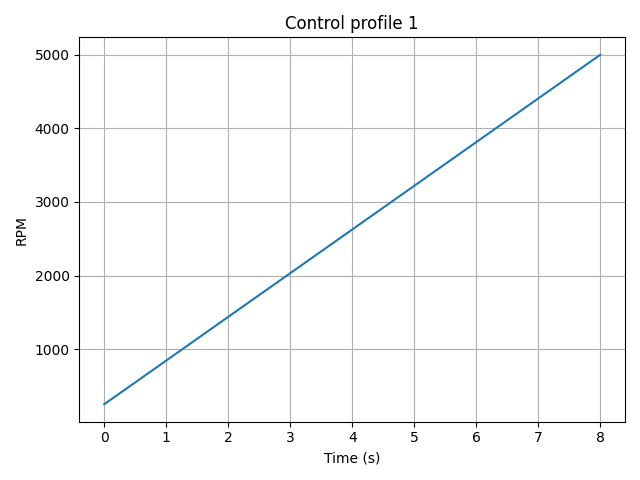
The track also contains a filter, stored as a Filter object.
Here, it is a finite impulse response (FIR) filter that models the transfer between the source
and the listening position.
track_gear.filter
print(track_gear.filter)
Sampling frequency: 44100.0 Hz
Numerator coefficients (B): [0.00728599214926362, 0.01836213283240795, 0.02472005784511566, 0.028517061844468117, 0.033101245760917664, ... ]
Denominator coefficients (A): [1.0]
Let us generate the signal corresponding to the track using the Track.process() method,
plot its waveform, and display its spectrogram with the Stft class.
track_gear.process(sampling_frequency=44100.0)
track_gear.plot()
spectrogram_gear = Stft(signal=track_gear.get_output())
spectrogram_gear.process()
spectrogram_gear.plot()
If needed, you can access the output signal of a track using Track.get_output().
signal_gear = track_gear.get_output()
Generate the signal of the project#
Now, let us generate the signal of the project using the SoundComposer.process() method.
This method generates, for each track, the acoustic signal of the source, filters it with the
associated filter, if any, and applies the track gain, and finally sums all resulting tracks’
signals together.
Generate the signal of the project, using a sampling frequency of 44100 Hz.
sound_composer_project.process(sampling_frequency=44100.0)
You can display the waveform of the generated signal using the SoundComposer.plot()
method, and its spectrogram using the Stft class.
sound_composer_project.plot()
spectrogram = Stft(signal=sound_composer_project.get_output())
spectrogram.process()
spectrogram.plot()
Conclusion#
This workflow allows you to analyze and listen to the sound of the gearbox and the e-motor, in realistic conditions, that is, including the HVAC noise and the background noise inside the cabin.
By analyzing the spectrogram, you can anticipate how some harmonic tones from the e-motor and the gearbox may be perceived by the passengers in the cabin.
Further investigations can be conducted, using other tools included in PyAnsys
Sound, such as modules Standard levels,
Psychoacoustics and
Spectral processing.
Total running time of the script: (0 minutes 39.908 seconds)


